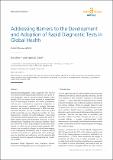Addressing Barriers to the Development and Adoption of Rapid Diagnostic Tests in Global Health
Author(s)
Miller, Eric Alexander; Sikes, Hadley
DownloadSikes_Addressing barriers.pdf (969.8Kb)
PUBLISHER_CC
Publisher with Creative Commons License
Creative Commons Attribution
Terms of use
Metadata
Show full item recordAbstract
Immunochromatographic rapid diagnostic tests (RDTs) have demonstrated significant potential for use as point-of-care diagnostic tests in resource-limited settings. Most notably, RDTs for malaria have reached an unparalleled level of technological maturity and market penetration, and are now considered an important complement to standard microscopic methods of malaria diagnosis. However, the technical development of RDTs for other infectious diseases, and their uptake within the global health community as a core diagnostic modality, has been hindered by a number of extant challenges. These range from technical and biological issues, such as the need for better affinity agents and biomarkers of disease, to social, infrastructural, regulatory and economic barriers, which have all served to slow their adoption and diminish their impact. In order for the immunochromatographic RDT format to be successfully adapted to other disease targets, to see widespread distribution, and to improve clinical outcomes for patients on a global scale, these challenges must be identified and addressed, and the global health community must be engaged in championing the broader use of RDTs.
Date issued
2015-06Department
Massachusetts Institute of Technology. Department of Chemical EngineeringJournal
Nanobiomedicine
Publisher
InTech
Citation
Miller, Eric, and Hadley D. Sikes. “Addressing Barriers to the Development and Adoption of Rapid Diagnostic Tests in Global Health.” Nanobiomedicine (2015): 1.
Version: Final published version
ISSN
1849-5435